Have you ever been mystified by those stoic souls aboard your flight, sitting as still as statues for hours on end while you twist and turn, seeking some semblance of comfort? I certainly have, and it’s a marvel to behold. Picture this: a large gentleman, not obese but undeniably large, sitting next to me, managing to maintain a state of absolute stillness throughout a six-hour journey. At around 6 feet and 270 pounds, he was a formidable presence, yet there he was, arms not even grazing the armrests, facing forward like a sentinel. Not once did he seek a beverage or exhibit any signs of discomfort. Contrast that with my endeavor. At 5’5″ and a modest 130 pounds, comfort seemed an elusive dream. Despite my best efforts to remain considerate of my neighbors, crossing and uncrossing my legs and shifting in my seat, my back protested vehemently after just a couple of hours.
The Key to In-flight Comfort
This experience led me to ponder: How do these paragons of patience and stillness achieve their Zen-like state? Are they engaging in some form of stoic suffering, or perhaps they possess a secret knowledge that eludes the rest of us? As it turns out, the key to their tranquility might not be as mystifying as it seems. It’s a combination of preparation, the right tools, and a dash of determination.
For starters, the battle for in-flight comfort is significantly skewed depending on where you’re seated. The stark contrast between coach and business or first class isn’t just a matter of free beverages and early boarding. It’s the difference between a cramped, restless night and a restful slumber. Those lie-flat beds in the premium sections transform a long-haul flight from a trial of endurance into a pleasantly comfortable journey.
What about those of us who don’t have the luxury of turning left when boarding? Are we doomed to hours of discomfort? Not necessarily. While we might not be able to replicate the full luxury of a lie-flat bed, there are strategies and tools at our disposal that can make a world of difference. Noise-canceling headphones, for instance, are a game-changer. They cut through the constant hum of the engines and the ambient noise of fellow passengers, creating a personal oasis of calm. The difference is night and day, and for many, this alone can make sleep attainable.
Then there’s the matter of physical comfort. Finding the right travel pillow can be a journey in itself, with countless variations vying for the title of ‘best’. Yet, for those who prioritize portability and effectiveness, innovative solutions like the Trtl Pillow offer a welcome departure from the norm. Similarly, the humble eye mask, often overlooked, can be the final piece of the puzzle, shielding you from the ever-present cabin lights and signaling to your body that it’s time for rest.
Of course, preparing your body for sleep is just as important as quieting your mind. Swollen feet are a common plight on long flights, exacerbated by cramped conditions and limited movement. Swapping tight shoes for a pair of comfortable slippers can not only provide relief but also signal to your body that it’s time to wind down. And let’s not forget the importance of staying warm. The temperature on planes can drop significantly, and while airlines provide blankets, bringing your own can ensure you stay cozy throughout the flight.
Despite the best preparations, the elusive state of in-flight stillness and comfort remains a mystery to many. It prompts the question: Are these unwavering travelers simply better equipped, both mentally and physically, or is there a deeper secret to their serenity? As we delve deeper into the world of travel comfort and sleep aids, we might just uncover the answers we seek, and perhaps, on our next flight, we too can join the ranks of these impressive air travel champions.

The Arsenal for Perfect Flight Sleep
Dear travelers, buckle up because we’re diving deep into the arsenal for achieving that elusive perfect flight sleep, even when you’re wedged in the economy class, miles above the earth. It’s time to transform your airborne journey from a trial of endurance into a slice of travel heaven.
Starting with the auditory oasis in a sea of noise, noise-canceling headphones are your first-class ticket to tranquility. Imagine shutting out the world, the hum of the engines, the chatter of fellow passengers, and even the occasional cry of a baby. This isn’t just about enjoying your favorite tunes or catching up on the latest blockbuster in peace; it’s about creating a bubble of serenity where sleep can envelop you. Whether you’re team Bose, Beats, or SkullCandy, investing in a good pair of noise-canceling headphones is akin to gifting yourself a key to the kingdom of sleep.
Let’s talk about the throne of comfort – the travel pillow. Not all heroes wear capes; some come in the form of neck support. Forget about the traditional U-shaped pillows that end up being more of a nuisance than a help. The innovation game in travel pillows is strong, with options like the Trtl Pillow, which supports your neck in a natural position, offering a level of comfort that can make even the longest of flights feel like a short nap. Whether you’re a side sleeper yearning for some semblance of your comfy bed at home or someone who just needs that extra bit of support, finding the right travel pillow can be a game-changer.
What about the light, you ask? Enter the humble, yet mighty, eye mask. This little piece of fabric, seemingly insignificant, can be the barrier between you and the glaring cabin lights or the unwelcome sunrise peeking through your neighbor’s window shade. An eye mask not only signals to the world that you’re off-duty but also helps regulate your sleep cycle by simulating the darkness of night, no matter the time zone you’re flying across.
Don’t forget our feet, for they too deserve love and care on our high-flying adventures. Swelling, discomfort, and cold are common complaints, but they can be mitigated. Slip out of those tight shoes and into a pair of cozy slippers or compression socks. The signal to your body is clear – it’s time to relax. And for those who find the flat footrest inadequate, a foot hammock can provide that gentle elevation, mimicking the recline of a cozy bed, encouraging your body to wind down.

Staying warm is more than just a comfort; it’s a necessity. The temperature in the cabin can fluctuate, and while airlines provide blankets, having your own can be the difference between shivering through a movie or snoozing cozily under a blanket or scarf that smells like home.
While these tools are indispensable in your quest for sleep, let’s not overlook the importance of location. Be a vulture for legroom and the best seats. Sometimes, it’s worth the extra investment in premium coach, emergency exit rows, or being opportunistic about empty rows. Positioning matters, and having that extra space can feel like upgrading from a cramped studio to a spacious apartment.
The art of sleeping on a plane is a blend of the right tools, a touch of strategy, and a mindset geared towards making the best out of the journey. It’s about creating a personal haven amidst the chaos of travel, a cocoon where you can retreat, recharge, and maybe, just maybe, wake up refreshed and ready to dive into your next adventure. So, as your trusty guide in this quest for in-flight comfort, I leave you with this: May your flights be peaceful, your sleep deep, and your adventures grand. Until the skies call us again, happy travels, dear reader, and may you always fly in the comfort of your personal oasis.
Related posts:
How to Sleep on Long Flights like First Class – Travel Your Bucket
A flight attendant’s secrets to surviving long-haul flights
Long-haul flights: How bad are seats next to lavatories?





